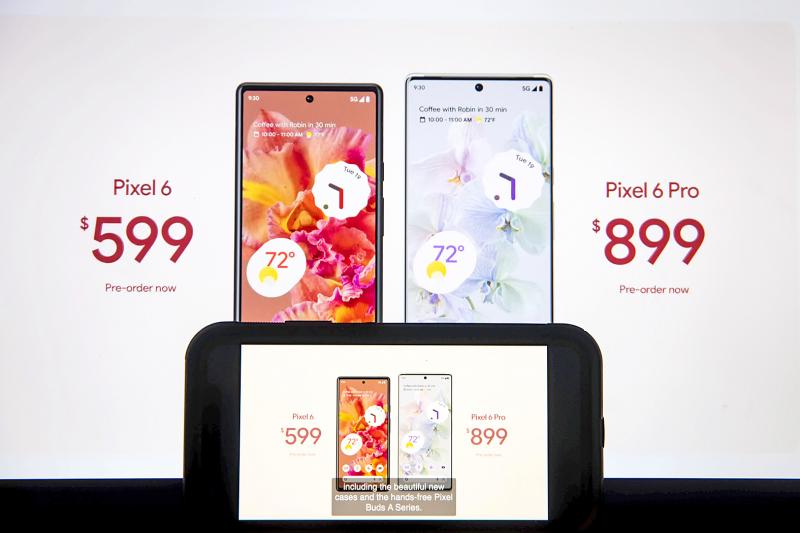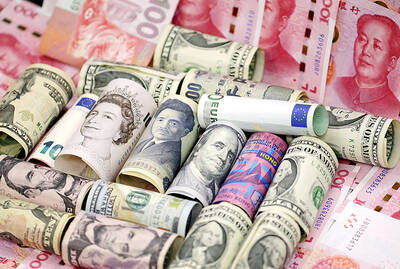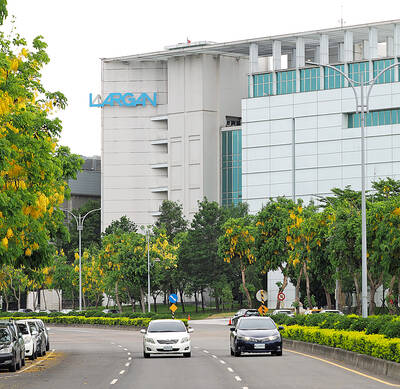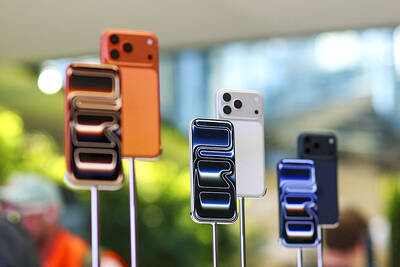Google on Tuesday launched the latest Pixel smartphones, betting on its first custom-designed system processor and a new version of the Android operating system to lure buyers away from Apple Inc’s iPhone.
The Pixel 6 and 6 Pro differ only slightly in size, memory and camera specs, with both built around Google’s Tensor system-on-chip, a custom semiconductor that took four years of development.
Tensor is optimized for Google’s strengths in image processing and artificial intelligence, helping deliver faster and more accurate speech recognition and better battery life.

Photo: Bloomberg
While Google’s Android is the top smartphone operating system globally, the Alphabet Inc unit has a minuscule market share in mobile handsets.
The company is now trying to stand apart from the competition with its own processor, joining Apple in making such a move.
“Mobile chips simply haven’t been able to keep pace with Google research,” said Google Silicon senior director Monika Gupta at the company’s launch event. “And rather than wait for them to catch up, we decided to make one ourselves.”
The 6.4-inch Pixel 6 costs US$599 and the 6.7-inch Pixel 6 Pro costs US$899, both shipping on Thursday next week.
Google’s online store crashed as shoppers tried to order the new devices immediately following their announcement.
Outside of the iPhone, most smartphones rely on Qualcomm Inc and, to a lesser degree, MediaTek Inc (聯發科) for their processors, leading to a relative lack of differentiation.
In addition to the Tensor, Google’s new devices include the company’s Titan M2 security chip, tasked with handling jobs such as passcode protection, encryption and secure transactions in apps.
Android 12, the latest version of the software, marks what Google calls the biggest design change in its history. It features personalization through color palettes and redesigned widgets, and privacy indicators signal when an app is accessing the device’s microphone or camera.
Its safety features are to ensure that Google’s audio and language processing happens exclusively on the device.
“There is still a huge swathe of consumers who don’t know that Google makes phones or in some cases, that Android is a Google product,” CCS Insight lead analyst Ben Wood said. “Google is clearly excited about the chip it is offering with the Pixel, but history has shown that mass market consumers will care little about custom silicon.”
The pricier 6 Pro model has 12GB of memory, compared with the Pixel 6’s 8GB, includes an extra 4x zoom camera and has a larger battery.
The bigger device also has an adaptive display refresh rate, much like the iPhone 13 — scaling from 120Hz for fast-moving on-screen action or animations down to 10Hz to preserve battery life.
Google and Apple are competing in a much-changed smartphone market this year, as Chinese Android vendors from Oppo Mobile Telecommunications Corp (歐珀) to Vivo Communication Technology Co (維沃) to Xiaomi Corp (小米) have improved significantly in the chase to fill the gap left by sanction-stricken Huawei Technologies Co (華為).
Vivo, for instance, has collaborated with Carl Zeiss on its lenses and its recently launched X70 Pro+ flagship has four gimbal-stabilized cameras on its rear.
Google still has to prove that the Pixel can be more than a niche gadget for an audience loyal to its products and reliant on its services.
The company has asked suppliers to double their production this year to more than 7 million units of the Pixel 6 smartphones, the Nikkei reported, citing people familiar with the company’s plans.

Taiwan’s foreign exchange reserves hit a record high at the end of last month, surpassing the US$600 billion mark for the first time, the central bank said yesterday. Last month, the country’s foreign exchange reserves rose US$5.51 billion from a month earlier to reach US$602.94 billion due to an increase in returns from the central bank’s portfolio management, the movement of other foreign currencies in the portfolio against the US dollar and the bank’s efforts to smooth the volatility of the New Taiwan dollar. Department of Foreign Exchange Director-General Eugene Tsai (蔡炯民)said a rate cut cycle launched by the US Federal Reserve

Handset camera lens maker Largan Precision Co (大立光) on Sunday reported a 6.71 percent year-on-year decline in revenue for the third quarter, despite revenue last month hitting the highest level in 11 months. Third-quarter revenue was NT$17.68 billion (US$581.2 million), compared with NT$18.95 billion a year earlier, the company said in a statement. The figure was in line with Yuanta Securities Investment Consulting Co’s (元大投顧) forecast of NT$17.9 billion, but missed the market consensus estimate of NT$18.97 billion. The third-quarter revenue was a 51.44 percent increase from NT$11.67 billion in the second quarter, as the quarter is usually the peak

The US government on Wednesday sanctioned more than two dozen companies in China, Turkey and the United Arab Emirates, including offshoots of a US chip firm, accusing the businesses of providing illicit support to Iran’s military or proxies. The US Department of Commerce included two subsidiaries of US-based chip distributor Arrow Electronics Inc (艾睿電子) on its so-called entity list published on the federal register for facilitating purchases by Iran’s proxies of US tech. Arrow spokesman John Hourigan said that the subsidiaries have been operating in full compliance with US export control regulations and his company is discussing with the US Bureau of

Pegatron Corp (和碩), a key assembler of Apple Inc’s iPhones, on Thursday reported a 12.3 percent year-on-year decline in revenue for last quarter to NT$257.86 billion (US$8.44 billion), but it expects revenue to improve in the second half on traditional holiday demand. The fourth quarter is usually the peak season for its communications products, a company official said on condition of anonymity. As Apple released its new iPhone 17 series early last month, sales in the communications segment rose sequentially last month, the official said. Shipments to Apple have been stable and in line with earlier expectations, they said. Pegatron shipped 2.4 million notebook